Navajo Three-stone Turquoise and Sterling Silver Bracelet - C3789B
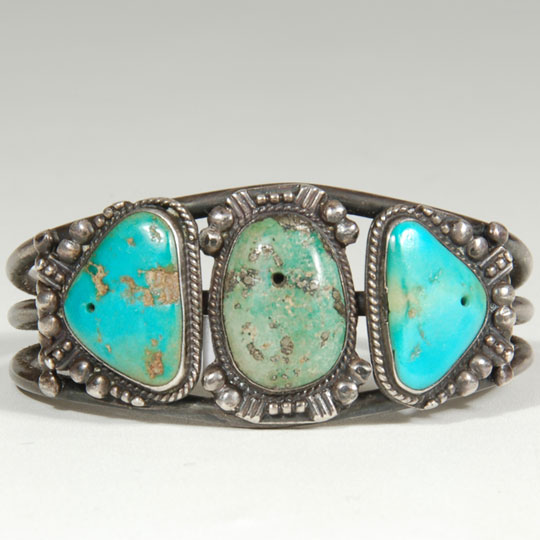 Recycling in the Native jewelry business is a relatively new procedure. It consists of taking very high quality turquoise stones from a tab necklace and repurposing them in another item of jewelry, overlooking the drill holes as being detrimental.
Recycling in the Native jewelry business is a relatively new procedure. It consists of taking very high quality turquoise stones from a tab necklace and repurposing them in another item of jewelry, overlooking the drill holes as being detrimental.
Much of the early turquoise jewelry had very high quality desirable turquoise. The stones used in older nugget necklaces were sometimes drilled off center, as are the two stones on the outer edges of this bracelet. The center stone was drilled in its center. The combination of the three stones is perfect for this bracelet.
Black on Red Hopi Pueblo Seed Jar by Mark Tahbo - 25863
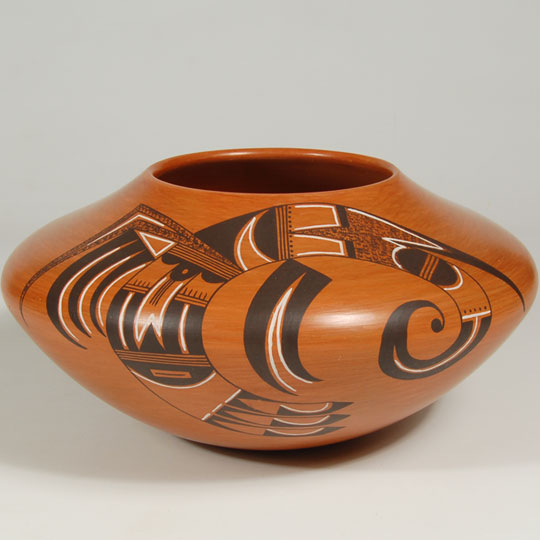 Mark Tahbo has surprised us again. He brought us a Hopi seed jar different from any he has shown us before. Normally, all of his jars are made in that beautiful orange blush that most Hopi potters produce. This jar, however, is one of the older styles executed in red. Mark said he got the idea of using a different clay to see if he could produce a jar in tribute to famous Hopi potter Garnet Pavatea. Garnet seemed to prefer using "yellow clay" that was available just below the mesa top at First Mesa, a source no longer accessible. It became necessary to construct a wall over the clay source to prevent that area of the mesa from collapsing.
Mark Tahbo has surprised us again. He brought us a Hopi seed jar different from any he has shown us before. Normally, all of his jars are made in that beautiful orange blush that most Hopi potters produce. This jar, however, is one of the older styles executed in red. Mark said he got the idea of using a different clay to see if he could produce a jar in tribute to famous Hopi potter Garnet Pavatea. Garnet seemed to prefer using "yellow clay" that was available just below the mesa top at First Mesa, a source no longer accessible. It became necessary to construct a wall over the clay source to prevent that area of the mesa from collapsing.
Zia Pueblo Painting of a Single Figure Male Dancer by Rafael Medina - 25383
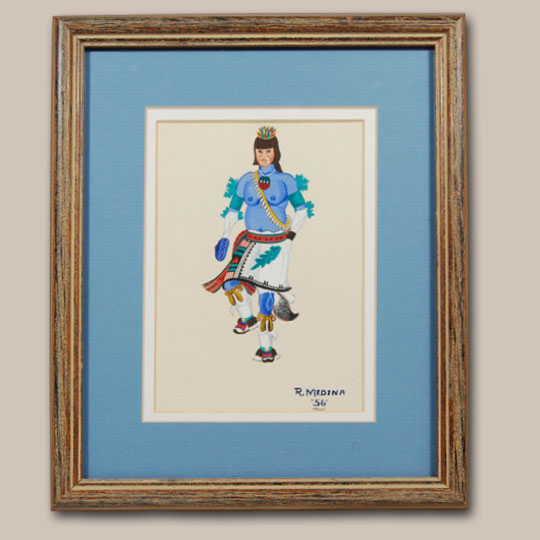 Rafael Medina (1929-1998) Teeyacheena of Zia Pueblo was known for painting in the typical traditional flat style. He received his education at the Zia Day School at Zia Pueblo, as well as at the Albuquerque Indian School. He also studied under the stewardship of Velino Shije Herrera, Jose Rey Toledo and Geronima Montoya at the Santa Fe Indian School.
Rafael Medina (1929-1998) Teeyacheena of Zia Pueblo was known for painting in the typical traditional flat style. He received his education at the Zia Day School at Zia Pueblo, as well as at the Albuquerque Indian School. He also studied under the stewardship of Velino Shije Herrera, Jose Rey Toledo and Geronima Montoya at the Santa Fe Indian School.
A Pair of Paintings of Pueblo Corn Dancers by Tonita Peña - C3789E-F
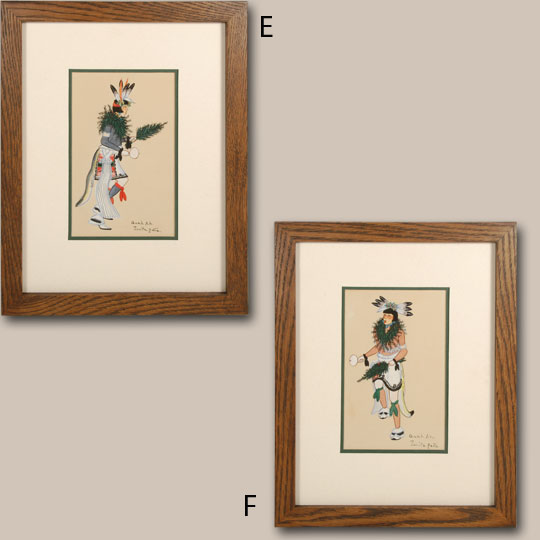 Tonita Vigil Peña (1893-1949) Quah Ah did not have an easy life. She lost her mother and sister when she was 12 years old and then was sent by her father from San Ildefonso, her native pueblo, to live with an aunt and uncle at Cochiti Pueblo. She essentially lost her father at that time as well. She had to learn new customs, dances, songs and even a new language, because Keres was spoken at Cochiti rather than Tewa, which was spoken at San Ildefonso.
Tonita Vigil Peña (1893-1949) Quah Ah did not have an easy life. She lost her mother and sister when she was 12 years old and then was sent by her father from San Ildefonso, her native pueblo, to live with an aunt and uncle at Cochiti Pueblo. She essentially lost her father at that time as well. She had to learn new customs, dances, songs and even a new language, because Keres was spoken at Cochiti rather than Tewa, which was spoken at San Ildefonso.
Original Navajo Painting of Hummingbirds and a Yei by Gerald Nailor - C3788D
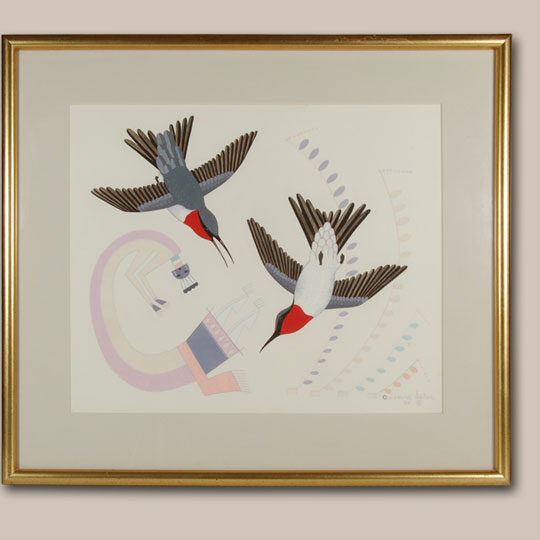 This original painting of hummingbirds and a Yei was among the last paintings made by Nailor, as he died the following year. At the time of his death, he was living with his family at Picuris Pueblo. Tragically, he was only 35 years old when he died from injuries received in an attempt to help a woman whose husband was brutally beating her. Dorothy Dunn's hope for his future would not happen. She stated "We hope this Navajo boy will keep to the proud Indian beauty, more and more, his eyes on the straight road. It must be hard in a world where garish lights beckon on all sides. He has humor as well as feeling for line."
This original painting of hummingbirds and a Yei was among the last paintings made by Nailor, as he died the following year. At the time of his death, he was living with his family at Picuris Pueblo. Tragically, he was only 35 years old when he died from injuries received in an attempt to help a woman whose husband was brutally beating her. Dorothy Dunn's hope for his future would not happen. She stated "We hope this Navajo boy will keep to the proud Indian beauty, more and more, his eyes on the straight road. It must be hard in a world where garish lights beckon on all sides. He has humor as well as feeling for line."
Original Painting of Koosa, Avanyu and Rainbow by J.D. Roybal - C3788E
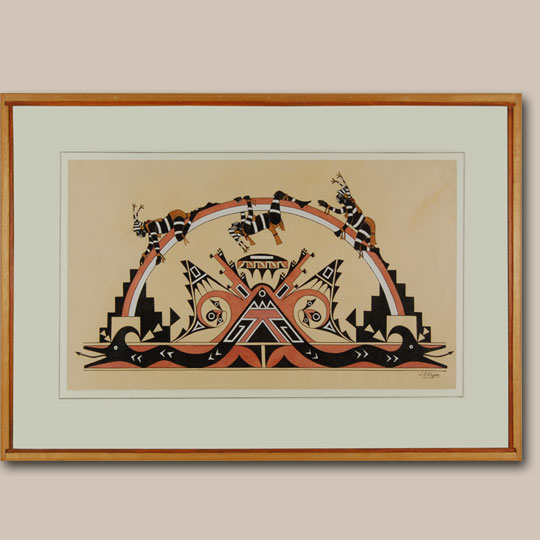 Having seen an original painting of Koosa, Avanyu and Rainbows by San Ildefonso Pueblo artist Awa Tsireh, printers at Tewa asked J. D. Roybal (Awa Tsireh's nephew) to paint something similar from which Tewa could make prints. Roybal practically copied his uncle's painting in detail, to the amusement of the Tewa staff. This painting is the original by J. D. Roybal from which Tewa did make silkscreen prints.
Having seen an original painting of Koosa, Avanyu and Rainbows by San Ildefonso Pueblo artist Awa Tsireh, printers at Tewa asked J. D. Roybal (Awa Tsireh's nephew) to paint something similar from which Tewa could make prints. Roybal practically copied his uncle's painting in detail, to the amusement of the Tewa staff. This painting is the original by J. D. Roybal from which Tewa did make silkscreen prints.
Cochiti Pueblo Pottery Storyteller with 2 Kids by Damacia Cordero - C3688.44
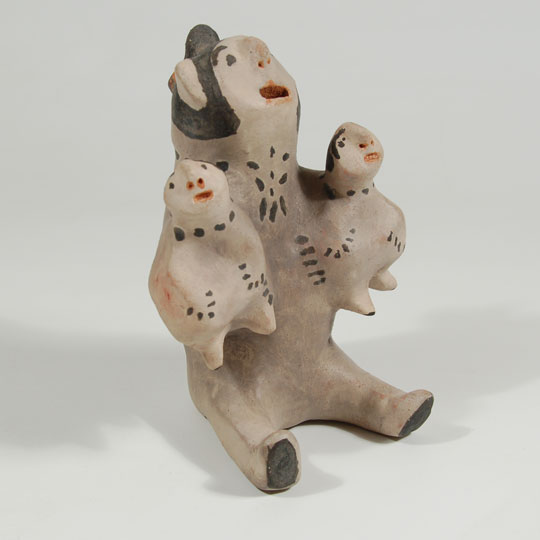 Damacia Cordero was a legend from Cochiti Pueblo. Her storyteller figurines and animal creations were unlike any other potter's work. This storyteller figurine, possibly a male, has the elongated torso, short legs, big ears, protruding nose and flat face of her traditional style.
Damacia Cordero was a legend from Cochiti Pueblo. Her storyteller figurines and animal creations were unlike any other potter's work. This storyteller figurine, possibly a male, has the elongated torso, short legs, big ears, protruding nose and flat face of her traditional style.
Cordero-style Male Storyteller with 5 Kids by Antonita Cordero Suina - C3688.30
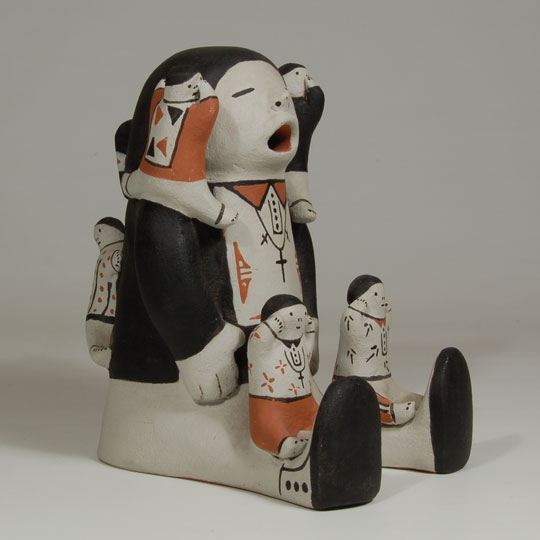 Antonita, or Toni, was a daughter of Fred and Helen Cordero. Her brother was George Cordero. Toni, George, George's daughter Buffy, and their cousin Tim Cordero all made storyteller figurines because of the influence of Helen Cordero. She taught all of them the fundamentals and any storyteller made by any of the younger generation is immediately recognizable as a product of a Cordero. They all resemble in some sense the work of Helen.
Antonita, or Toni, was a daughter of Fred and Helen Cordero. Her brother was George Cordero. Toni, George, George's daughter Buffy, and their cousin Tim Cordero all made storyteller figurines because of the influence of Helen Cordero. She taught all of them the fundamentals and any storyteller made by any of the younger generation is immediately recognizable as a product of a Cordero. They all resemble in some sense the work of Helen.
Cochiti Pueblo Male Storyteller with 6 Children by Buffy Cordero Suina - C3688.03
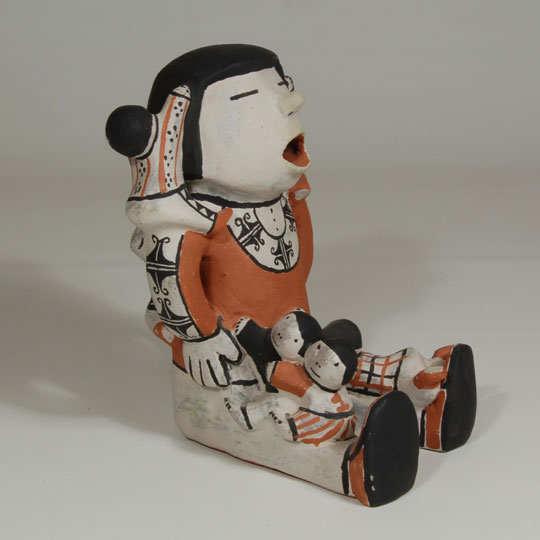 Buffy Cordero Suina (1969- ) was a granddaughter of Fred and Helen Cordero. Her mom and dad were George and Kathy Cordero. She credits her interest in pottery to her dad and her grandmother. It is most likely that Helen had more influence on Buffy as it appears that she quit potting following the death of Helen. Buffy started making storyteller figurines around 1985 while still a teenager.
Buffy Cordero Suina (1969- ) was a granddaughter of Fred and Helen Cordero. Her mom and dad were George and Kathy Cordero. She credits her interest in pottery to her dad and her grandmother. It is most likely that Helen had more influence on Buffy as it appears that she quit potting following the death of Helen. Buffy started making storyteller figurines around 1985 while still a teenager.
Zuni Pueblo Four Row Snake Eyes Turquoise and Silver Bracelet - C3789A
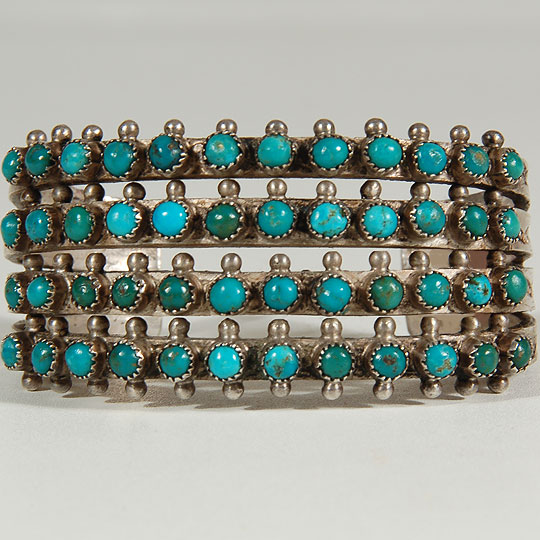 This bracelet was fashioned in a manner that took four individual silver bracelets and combined them into a single bracelet. They were attached at each end with solder. There are 12 silver drops between each row which serve as the anchor points to keep the bracelets separate. There are another 12 silver drops on the outer edge. The bracelet is topped with four rows, each containing 12 small round and domed turquoise cabs, commonly called snake eyes.
This bracelet was fashioned in a manner that took four individual silver bracelets and combined them into a single bracelet. They were attached at each end with solder. There are 12 silver drops between each row which serve as the anchor points to keep the bracelets separate. There are another 12 silver drops on the outer edge. The bracelet is topped with four rows, each containing 12 small round and domed turquoise cabs, commonly called snake eyes.
Hopi Pueblo Old Style Rugan Katsina Doll - C3784D
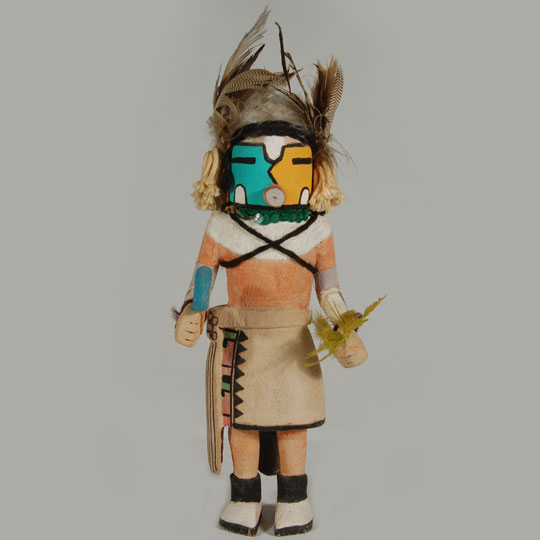 This is an older version of a Corn Katsina, the specific Hopi name may be Qa'ökatsina. Barton Wright referred to this as a Rugan, which is another group name for Corn Katsinas. Each of the Corn Katsinas has a specific Hopi name.
This is an older version of a Corn Katsina, the specific Hopi name may be Qa'ökatsina. Barton Wright referred to this as a Rugan, which is another group name for Corn Katsinas. Each of the Corn Katsinas has a specific Hopi name.
Large Oval Turquoise Stone and Silver Bracelet by Chief Sunny Skies - C3785F
 After a casual look at this bracelet, most knowledgeable collectors and dealers would identify it as having been made by a Navajo, as it is typically like the work of members of that tribe. This one, however, is clearly marked that it was made by Chief Sunny Skies of Acoma Pueblo. This one does not have a date stamped with the signature but the other two items we have had from this same collection that were signed by Chief Sunny Skies were dated 1938 and 1939, so it is presumed that this bracelet would probably have been made at that time.
After a casual look at this bracelet, most knowledgeable collectors and dealers would identify it as having been made by a Navajo, as it is typically like the work of members of that tribe. This one, however, is clearly marked that it was made by Chief Sunny Skies of Acoma Pueblo. This one does not have a date stamped with the signature but the other two items we have had from this same collection that were signed by Chief Sunny Skies were dated 1938 and 1939, so it is presumed that this bracelet would probably have been made at that time.
Original Painting of a Navajo Rug Weaving Session by Harrison Begay - C3788F
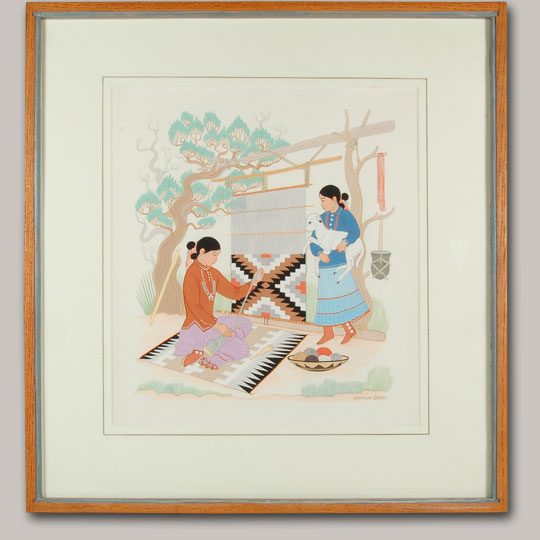 In 1951, an arts silk-screen printing business called Tewa Enterprises, was started in Santa Fe by Charles Barrows, a silkscreen printer, and Harrison Begay, the well-known Navajo painter. Tewa's mission was to hand silk-screen reproductions of Navajo and Pueblo paintings and make them available to a wide audience at low prices. Subsequently, the current owner, Cathie Sullivan purchased Tewa Enterprises.
In 1951, an arts silk-screen printing business called Tewa Enterprises, was started in Santa Fe by Charles Barrows, a silkscreen printer, and Harrison Begay, the well-known Navajo painter. Tewa's mission was to hand silk-screen reproductions of Navajo and Pueblo paintings and make them available to a wide audience at low prices. Subsequently, the current owner, Cathie Sullivan purchased Tewa Enterprises.
Very Deep Maricopa Reservation Basketry Bowl - C3776Y
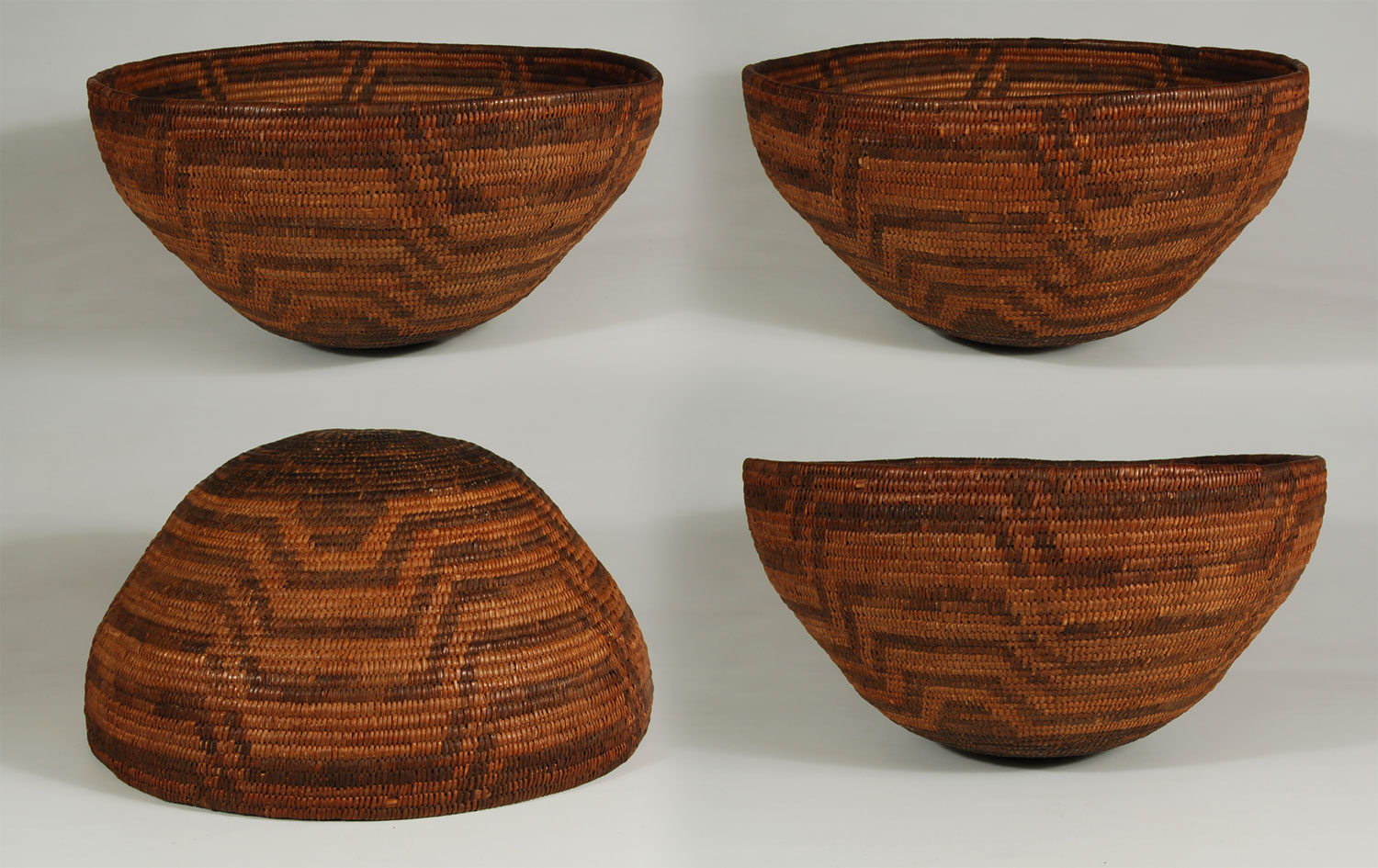 A number of tribes which speak the Yuman language have, for a number of years, been grouped together because their cultural patterns are similar. There are four Yuman-speaking tribes-one in California, one in Mexico, and two in Arizona. The Arizona Yuman-speaking tribes are known as the River Yuman tribe. They settled along the lower Colorado River and the Gila River, which provided for good farming. The three groups that make up the Arizona Yumans are Mohaves, Cocopas, and Maricopas.
A number of tribes which speak the Yuman language have, for a number of years, been grouped together because their cultural patterns are similar. There are four Yuman-speaking tribes-one in California, one in Mexico, and two in Arizona. The Arizona Yuman-speaking tribes are known as the River Yuman tribe. They settled along the lower Colorado River and the Gila River, which provided for good farming. The three groups that make up the Arizona Yumans are Mohaves, Cocopas, and Maricopas.
According to Andrew Hunter Whiteford, "most River Yuman baskets have long since disappeared." He states that the Maricopas are now primarily pottery makers and no longer make baskets.
This Maricopa basket is a very deep bowl that dates between 1900 and 1910. It has been described as a wine bowl but certainly could have served many functions for the owner. It is in such excellent condition because it probably never served a function for the tribe. It was probably sold shortly after completion. It is a very rare basket from a tribe no longer making them.
#adobegallery #SouthwestIndianBaskets #Maricopa #PeeposhTribe #Baskets #IndianBaskets
#SantaFeNM #VisitCanyonRoad
Very Large Ohkay Owingeh (San Juan) Pueblo Polychrome Storage Jar - C3773M
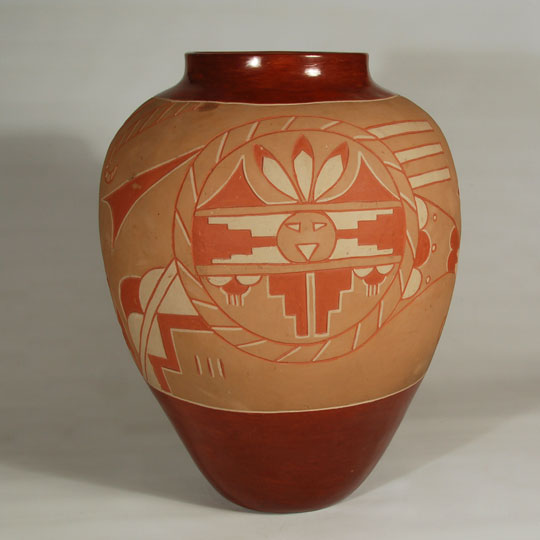 In 1930 Regina Cata organized a pottery study group at San Juan Pueblo with the intent of revitalizing pottery production. The group studied ancient potsherds of wares made at San Juan in earlier times and selected Potsuwi'i Incised Ware (1450-1500) as a basis for a contemporary pottery type. By the 1950s, further development resulted in deep carved polychrome wares, and incised wares, both of which are still being produced today.
In 1930 Regina Cata organized a pottery study group at San Juan Pueblo with the intent of revitalizing pottery production. The group studied ancient potsherds of wares made at San Juan in earlier times and selected Potsuwi'i Incised Ware (1450-1500) as a basis for a contemporary pottery type. By the 1950s, further development resulted in deep carved polychrome wares, and incised wares, both of which are still being produced today.
Santa Clara Black and Sienna Small Jar with Sgraffito Design by Kevin Naranjo - C3790B
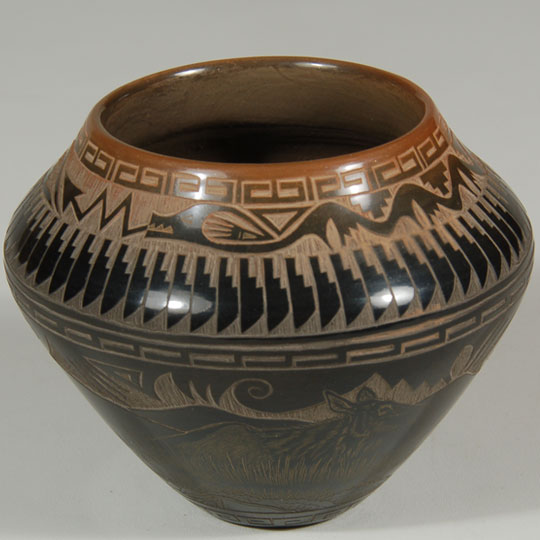 It is difficult to definitively establish the innovator of a pottery style or technique but it can be stated that Joseph Lonewolf of Santa Clara Pueblo was among the first, if not the first, to experiment with sgraffito designs in clay in the early 1970s. If there was another potter making sgraffito designs before then, I offer my apologies for not giving that person credit.
It is difficult to definitively establish the innovator of a pottery style or technique but it can be stated that Joseph Lonewolf of Santa Clara Pueblo was among the first, if not the first, to experiment with sgraffito designs in clay in the early 1970s. If there was another potter making sgraffito designs before then, I offer my apologies for not giving that person credit.
Santa Clara Drum Shape Polychrome Lidded Pottery Box by Dolores Curran - C3790A
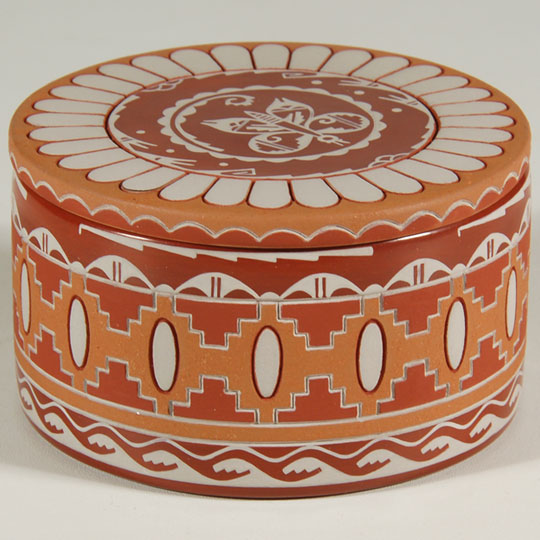 Dolores Curran, originally from Santa Clara Pueblo, married and moved to Ohkay Owingeh Pueblo around 1977. She has specialized in miniature pottery since her first piece at age 9. Her designs are each original to the piece of pottery on which she is working. She does not record her designs because she doesn't want to start copying herself. She prefers to fit each design to the pot on which it goes. She now designates her pottery as being from Santa Clara Pueblo.
Dolores Curran, originally from Santa Clara Pueblo, married and moved to Ohkay Owingeh Pueblo around 1977. She has specialized in miniature pottery since her first piece at age 9. Her designs are each original to the piece of pottery on which she is working. She does not record her designs because she doesn't want to start copying herself. She prefers to fit each design to the pot on which it goes. She now designates her pottery as being from Santa Clara Pueblo.
Santa Clara Pueblo Polychrome Rectangular Box with Lid by Belen Tapia - C3790D
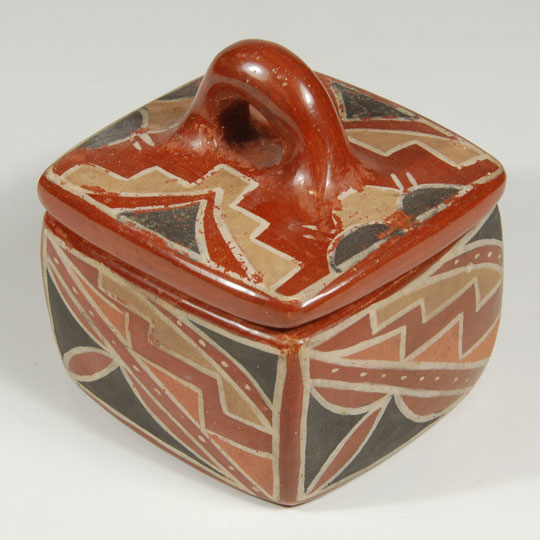 Lidded boxes such as this one might have been used in ceremonial functions at Tewa and other pueblos, but there is no information published as to the manner in which they were used. Such boxes also were made for sale to non-Native persons, mostly at the request of anthropologists, who were seeking them for museum collections. Individuals also liked to collect them for use as small storage boxes.
Lidded boxes such as this one might have been used in ceremonial functions at Tewa and other pueblos, but there is no information published as to the manner in which they were used. Such boxes also were made for sale to non-Native persons, mostly at the request of anthropologists, who were seeking them for museum collections. Individuals also liked to collect them for use as small storage boxes.
Jemez Pueblo Two-Piece Pottery Owl Figurine by Laura Gachupin - C3790C
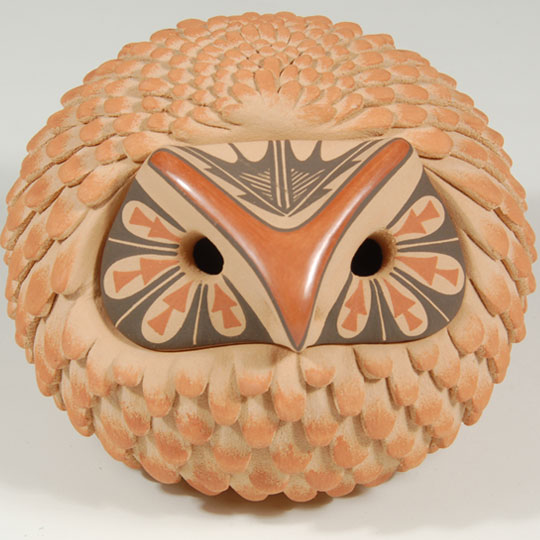 Laura Gachupin was born into a family of artists. Her sister is Maxine Toya, her mother was Marie Romero, and her grandmother was Persingula Gachupin. Her grandmother was her mentor. She also studied at the Institute of American Indian Arts in Santa Fe. She has won many awards for her work, and demonstrated both in and out of state.
Laura Gachupin was born into a family of artists. Her sister is Maxine Toya, her mother was Marie Romero, and her grandmother was Persingula Gachupin. Her grandmother was her mentor. She also studied at the Institute of American Indian Arts in Santa Fe. She has won many awards for her work, and demonstrated both in and out of state.
Kewa Pueblo Inlay Shell Pendant Coral Necklace with Earrings by Percy Reano - C3777D
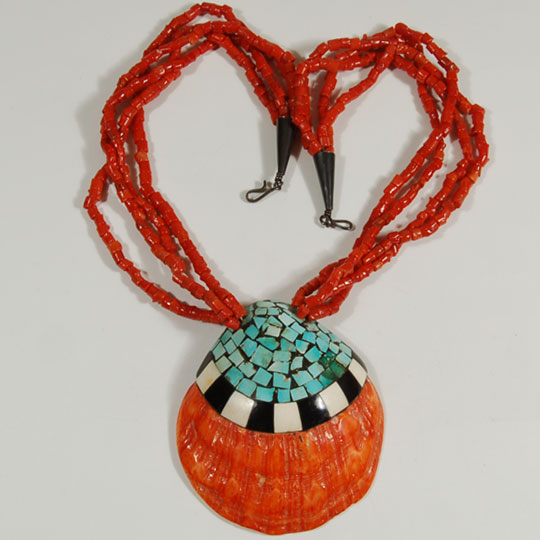 Over 65,000 pieces of turquoise were found at Pueblo Bonito at Chaco Canyon in New Mexico, leading archeologists to believe that Chaco was a turquoise manufacturing center. Both turquoise and shell were used for adornment by Ancestral Puebloans during prehistoric times, and both are still being used today.
Over 65,000 pieces of turquoise were found at Pueblo Bonito at Chaco Canyon in New Mexico, leading archeologists to believe that Chaco was a turquoise manufacturing center. Both turquoise and shell were used for adornment by Ancestral Puebloans during prehistoric times, and both are still being used today.
Anyone who has had the opportunity to attend a Pueblo plaza dance has seen the beautiful turquoise and shell pendants worn by dancers. This particular pendant is especially lovely as it is suspended by four strands of rare red coral. The artist carefully and skillfully set turquoise, jet and shell mosaic onto a smoothed down Spondylus or Spiny Oyster shell.


